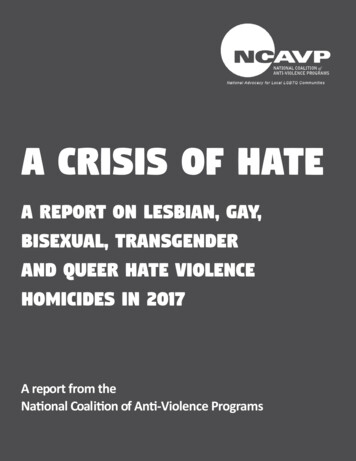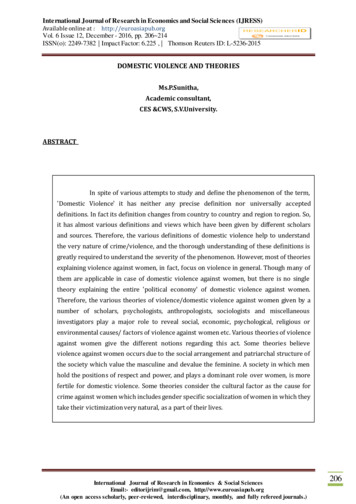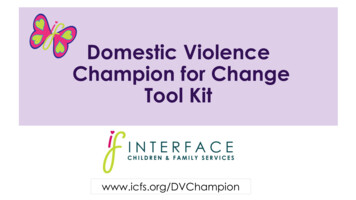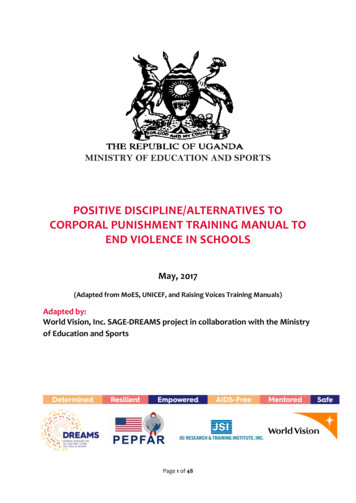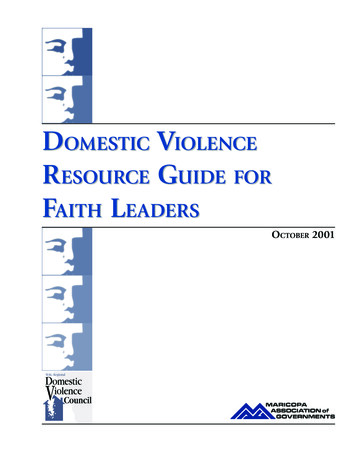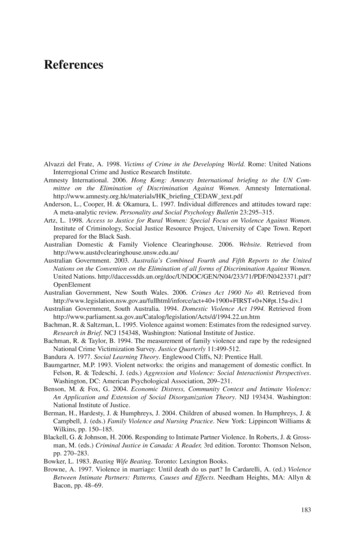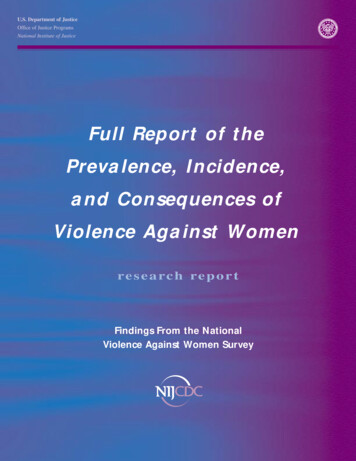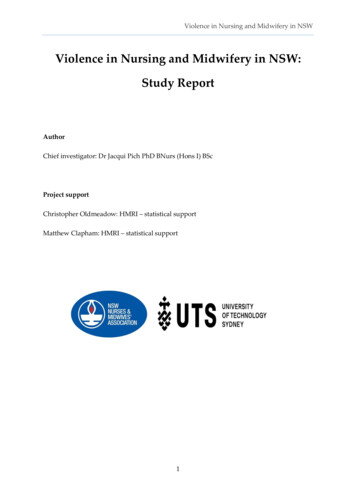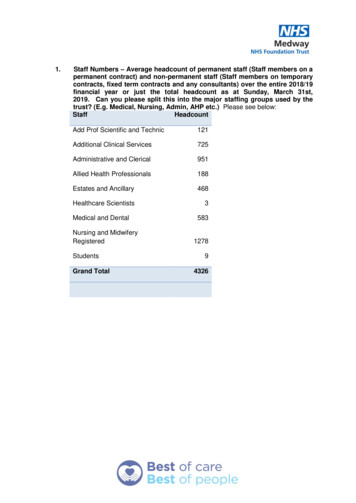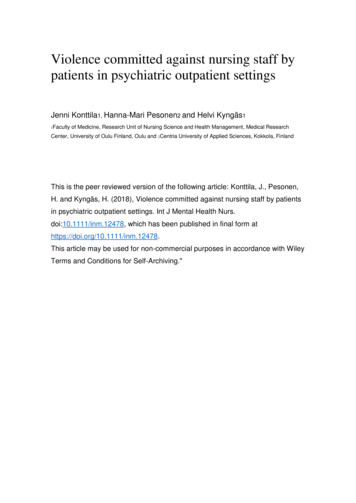
Transcription
Violence committed against nursing staff bypatients in psychiatric outpatient settingsJenni Konttila1, Hanna-Mari Pesonen2 and Helvi Kyngäs11Facultyof Medicine, Research Unit of Nursing Science and Health Management, Medical ResearchCenter, University of Oulu Finland, Oulu and 2Centria University of Applied Sciences, Kokkola, FinlandThis is the peer reviewed version of the following article: Konttila, J., Pesonen,H. and Kyngäs, H. (2018), Violence committed against nursing staff by patientsin psychiatric outpatient settings. Int J Mental Health Nurs.doi:10.1111/inm.12478, which has been published in final form athttps://doi.org/10.1111/inm.12478.This article may be used for non-commercial purposes in accordance with WileyTerms and Conditions for Self-Archiving."
ABSTRACTViolence against nurses has increased particularly in psychiatric outpatient settings aspsychiatric care shifts from being inpatient-based to being outpatient-based. Violence isa complex phenomenon that must be explored in different psychiatric nursingenvironments and settings. Violence in psychiatric outpatient settings should especiallybe explored as violence in this context has scarcely been examined. The aim of thissystematic review was to elucidate violence committed against nursing staff by patientsin adult psychiatric outpatient settings, based on reports from previous studies. Aliterature search was conducted in the CINAHL (EBSCO), Ovid MEDLINE, andPsycARTICLES (Ovid) databases. Fourteen studies emerged after the selection andquality assessment process. These studies indicated that violence in psychiatric outpatientsettings is a multidimensional phenomenon comprising the reasons for, forms of, andconsequences of violence. Reasons for violence could be related to the patient as well asto nursing staff. In psychiatric outpatient settings, verbal violence was the most commonform of violence, and violence most frequently led to psychological consequences fornursing staff. The findings of this review highlight the importance of nursing staffdeveloping skills and interventions for managing different kinds of violent situations.Given the multidimensional consequences of violence, attention must be given to theoccupational wellbeing and coping ability of nursing staff at work. Furthermore, it wouldbe worthwhile to compare cultural and intercountry differences of violent exposures inpsychiatric outpatient settings.Key words:violence, psychiatric nursing, outpatient setting, nursing staff,
INTRODUCTIONViolence against nurses has increased in healthcare settings (Choiniere et al. 2014,Gillespie et al. 2010) and particularly in psychiatric nursing (Maguire & Ryan 2007,Nolan et al. 2001). Incidents of violence are common in psychiatric inpatient settings(McTiernan & McDonald 2015) and have also increased in psychiatric outpatient settings(Maguire & Ryan 2007) as mental health services shift from being inpatient-based tobeing outpatient-based (Ward & Cowman 2007).Violence may comprise physical, psychological, or verbal abuse aimed at hurting anotherperson by causing physical injuries or psychological trauma (WHO 2002a). Inheritedgenes and social environments, physical and social factors, and personal characteristicsall influence a person’s violent behaviour (Allen et al. 2018). Biological, psychosocial,and environmental factors can cause violent behaviour (Allen et al. 2018, Rueve &Welton 2008), and psychotic and personality disorders increase the risk of violentbehaviour (Rueve & Welton 2008).Workplace violence is defined as an incident involving abuse, threat, or assault of staff incircumstances related to their work that aims to threaten their safety, wellbeing, or health(WHO 2002b). Healthcare professionals like nurses are potentially at high risk ofworkplace violence; this risk has increased and has become a global problem (WHO2002b). An estimated 8-38% of nursing staff experiences some kind of violence duringtheir career (WHO 2017). Female nursing staff are at especially increased risk of fallingvictim to violence (Gillespie et al. 2010, WHO 2002b). Employee’s age, work experience,
and skills in managing violent situations influence the risk of falling victim to violence(Gillespie et al. 2010). Studies have also revealed cultural and intercountry differencesbetween violent exposures (Camerino et al. 2008, Spector et al. 2014). One study suggeststhat organisational factors, like the type of workplace, can also influence the amount ofexposure to violence (Shea et al. 2017). From the perspective of psychiatric nursing,nursing staff working in psychiatric outpatient settings may be at greater risk of workplaceviolence than staff working in psychiatric inpatient settings because work in outpatientsettings is often independent and lonely (Nolan et al. 2001).Previous studies report that psychiatric nurses are at greater risk of exposure to violencethan nurses working in other nursing fields (Blando et al. 2013, Edward et al. 2016).Studies also highlight that exposure to violence has physical and psychological effects onvictims (Maguire & Ryan 2007, Stevenson et al. 2015, Zeng et al. 201). Workplaceviolence is also associated with occupational quality of life and turnover intentions (Choi& Lee 2017). Workplace violence can also vicariously damage victim’s familyrelationships (Najafi et al. 2017). According to studies, nursing staff require professionalskills and the ability to use different kinds of preventive interventions to manage violentsituations (Choiniere et al. 2014, Irwin 2006).Violence is a complex phenomenon and must be explored in different psychiatric nursingenvironments and settings (Lanza et al. 2006, Otto 2000, Woods & Ashley 2007). Manystudies of violence have been conducted from the perspective of the inpatient setting(Woods & Ashley 2007), but violence also occurs in psychiatric outpatient settings
(Lanza et al 2006). Since, the latter is the lesser examined setting, this systematic reviewfocused on violence committed against nursing staff by patients in outpatient settings inadult psychiatry. This review consolidated knowledge about factors related to thisphenomenon of interest. Research-based knowledge of this phenomenon is importantbecause the high risk of violence against nurses is increasing (WHO 2002b), andpsychiatric services are shifting toward outpatient-based services (European commission2008).
AIMThe aim of this systematic review is to elucidate, based on previous studies, the violencecommitted against nursing staff by patients in outpatient settings in adult psychiatry. Theresearch question was: what factors are associated with violence committed againstnursing staff by patients in outpatient settings in adult psychiatry?
METHODSResearch methodThis systematic review was conducted according to the guidelines of the Centre forReviews and Dissemination (CRD 2009). The research question was set using the PIComodel, where P (population) was the nursing staff, I (phenomenon of Interest) was theviolence against nursing staff committed by patients, and C (context) comprised theoutpatient settings in adult psychiatry.Data collectionA literature search of the following databases was conducted: CINAHL (EBSCO), OvidMEDLINE, and PsycARTICLES (Ovid). Search terms were (community mental healthOR community care), (outpatient setting*), (mental health setting* OR mental healthservice*), (nurs* OR service*), (psychiatric nurs* OR mental health nurs*), (mentalhealth* OR psychiatric*), (violen* OR aggress*), (adult*), (outpatient). Search termswere based on the research question and were clarified after a preliminary search with thehelp of an information skills specialist. The search was conducted using differentcombinations of these search terms. Figure 1 shows the study selection process.The inclusion criteria for this systematic review were based on the research question andwere as follows: English or Finnish language, full-text availability, and peer-reviewedoriginal nursing science or medical research article related to outpatient settings in adultpsychiatry, or outpatient and inpatient settings in adult psychiatry if results on theoutpatient settings were reported separately. No limit for methodology was set becausethe purpose of data collection was to gather studies with diverse methodologies and
produce a heterogeneous dataset. A heterogeneous dataset enables versatility inexamination of the investigated phenomenon (Aromataris & Pearson 2014). The timerange was set from 1997 to 2017 because psychiatric outpatient settings have increasedin number over the past twenty years (Maquire & Ryan 2007).The critical appraisal was conducted according to the guidelines of the Joanna BriggsInstitute (JBI 2014). The Qualitative Assessment Research Instrument (QARI), includingten assessment criteria, was used for quality assessment of qualitative studies and theMeta-Analysis of Statistics Assessment and Review Instrument (MAStARi), includingnine assessment criteria, was used for quality assessment of quantitative studies (JBI2014). Five or more points on a critical appraisal indicated good quality, because fivepoints was half or more than half of the achievable points. Study selection and criticalappraisal were both conducted by two researchers independently, who thencommunicated to reach agreement at the end of the processes. There was no disagreementbetween the two researchers after completion of study selection and critical appraisal.After critical appraisal, 14 studies remained for data analysis.Data analysisData was extracted from the studies included (Table 1) to facilitate acquisition of thenecessary information about study characteristics and findings (CRD 2009). Narrativesynthesis, which aims to describe patterns across studies and analyze relationshipsbetween data, was chosen for data analysis because it is an appropriate synthesis methodfor clinically- or methodologically-diverse studies (CRD 2009). Narrative synthesis wasconducted by first grouping the data into clusters and using colour-coding to develop a
preliminary synthesis. Similar clusters were then combined. The conceptual mappingtechnique, a visual and graphical method that organises and represents knowledge usingcontent maps (CRD 2009), was used to explore relationships between studies. Finally,the robustness of analysis was evaluated with critical reflection. The analysis identifiedthree main factors associated with violence and the relationships between them: reasonsfor violence, forms of violence, and consequences of violence.
RESULTSData was extracted from 14 studies. Six studies focused only on psychiatric outpatientsettings and eight examined violence in both inpatient and outpatient psychiatric settings.In these latter eight studies, findings on outpatient and inpatient settings were reportedseparately. Study approaches included qualitative (n 1) and quantitative (n 11) methodsand mixed methods (n 2), and studies were conducted in Australia (n 2), Japan (n 1),Sweden (n 2), and the United States of America (n 8). Participants were psychiatricnursing staff in seven studies, and psychiatric patients in seven studies.Factors associated to violenceViolence in psychiatric outpatient settings is a multidimensional phenomenon. There canbe recognized reasons of violence, forms of violence and consequences of violence.Both patients and nursing staff contributed to the reasons for violence. According to thestudies included in the systematic survey, the reasons for a patient’s violent behaviourinclude the patient’s young age, prior experiences with violence (Flannery et al. 2001a,Swanson et al. 1999), substance abuse (Flannery et al. 2001a, Swanson et al. 1999), andprior history of violent behaviour (Flannery & Walker 2001, Rao et al. 2007). Reasonsfor violent behaviour also include psychiatric diseases like schizophrenia (Flannery et al.2001a, Rao et al. 2007) and personality disorders (Rao et al. 2007). Denial of services,acute psychosis, experiences with negative attitudes of the nursing staff, and medicationnoncompliance (Flannery et al. 2011), patient’s romantic feelings toward nursing staff,and hallucinations (Flannery et al. 2001a, Flannery et al. 2011) were all reasons for
patient’s violent behavior identified from the included studies. Moreover, feelings ofbeing unsafe could increase the risk of violent behaviour (Flannery et al. 2001a).The studies reported that males are at greater risk of committing violent behaviour thanfemales (Flannery et al. 2001a) but, in practice, females more frequently commit mostviolent attacks, excluding sexual attacks (Flannery & Walker 2001). The patient was mostoften the perpetrator of violence (Tonso et al. 2016) but sometimes the perpetrator wasalso the patient’s family member (Fujimoto et al. 2017).Reasons one falls victim to violence from the perspective of nursing staff include: workconditions and work-environment-related physical and psychological factors such as thecharacteristics of the physical environment, number of staff supervisors, and workatmosphere (Soares et al. 2000). Staff member’s age, duration of work experience, andstaff member’s views on quality of care and organisational factors like lack of resourcesand social support (Soares et al. 2000) all influenced the risk of falling victim to violence.Studies showed that males are at increased risk of attack by male patients, but females areat increased risk of attack by both male and female patients (Flannery et al. 2007, Flanneryet al 2001b).The most frequently-occurring form of violence was verbal violence (Flannery et al.2001a, Fry et al. 2002, Fujimoto et al. 2017, Lewis & Dehn 1999, Tonso et al. 2016).Nursing staff experienced verbal sexual harassment (Flannery et al. 2001a, Flannery &Walker 2001, Fry et al. 2002, Tonso et al. 2016) and threats (Fry et al. 2002, Fujimoto et
al. 2017). Physical violence also occurred (Flannery et al. 2001a, Flannery & Walker2001, Fry et al. 2002, Fujimoto et al. 2017) and sometimes involved some kind of weapon,like a knife (Fry et al. 2002, Lewis & Dehn 1999). Studies also reported property damageand destruction (Fry et al. 2002, Fujimoto et al. 2017).The consequences of violence were either direct or indirect. Physical violence causedimmediate consequences like physical injuries (Flannery & Walker 2001, Fry et al. 2002).Emotional reactions, like anxiety (Fry et al. 2002), emotional exhaustion (Fry et al. 2002,Tonso et al. 2016), feelings of vulnerability (Fry et al. 2002, Lewis & Dehn 1999) andviolated psychological integrity (Fry et al. 2002), are indirect consequences of violence.Violent experiences led to increased concern of loved-ones for staff members’ safety(Lewis & Dehn 1999), increased use of sick leave (Soares et al. 2000, Tonso et al. 2016),and increased risk of post-traumatic stress disorder (Fujimoto et al. 2017). Greaterexposure to more forms of violence significantly increased psychological distress (Tonsoet al. 2016). Sexual attacks, non-verbal intimidation, and verbal threats increasedpsychological fear (Flannery & Walker 2001). Due to violence, the perpetrator could endup in psychiatric hospital (Flannery et al. 2001a).Relationships between factors associated with violenceExamination of the relationships between the factors associated with violence revealedthat the factors are strongly connected and influence each other.
When violent situations occurred, reasons for violence, the forms of violence, and theconsequences of violence were connected by place and time. Violent behaviour occurredin mental health centers (Fry et al. 2002, Swanson et al. 1999), at the perpetrator’s home(Fry et al. 2002, Fujimoto et al. 2017, Swanson et al. 1999), and in other places like daycenters (Fry et al. 2002). Comparisons of months, days of the week, and times of the dayshowed that the risk of violent behaviour increased in March, on Sunday, and during themorning time (Flannery et al. 2010).Nursing-staff-related reasons for violent behaviour were also associated with forms ofviolence because females were at significantly higher risk of sexual attack, non-verbalthreats, and verbal attack (Flannery & Walker 2001). On the other hand, longer durationsof work experience were associated with increased risk of sexual harassment (Fujimotoet al. 2017). Longer durations of work experience and greater numbers of monthly visitswere associated with increased risk of verbal violence (Fujimoto et al. 2017). Also,reactions of nursing staff members could influence violence and the threat of violencebecause their ability to be present and their skills in dialogue helped with constructivehandling of violent situations (Carlsson et al. 2004). Nursing staff members’psychological absence, feelings of fear, and demonstrations of feelings of fear could allescalate a violent situation (Carlsson et al. 2004). Verbal communication and bodylanguage by nursing staff were also essential for handling violent situations (Carlsson etal. 2004).
No reported differences between aggressiveness, adherence, or compliance withtreatment and patient history of violence were reported, considering the backgroundvariables associated with reasons for patient violent behaviour (Rao et al. 2007).Moreover, no differences between background variables and single factors associatedwith violence were reported (Flannery et al. 2011).
DISCUSSIONThis systematic review confirmed that violence committed by patients against nursingstaff in psychiatric outpatient settings is a multidimensional phenomenon comprisingthree factors: reasons for violence, forms of violence, and consequences of violence. Thefindings of this review also show that these factors are connected to each other andinfluence each other.The findings of this review indicate that the usual reasons for patients’ violent behaviourare male gender, young age, substance use, and prior history of violence combined withpsychiatric disorders like schizophrenia or personality disorder. According to Ose et al.(2017), the risk of patient violent behaviour has increased in both psychiatric inpatientand outpatient settings. In their study, patient’s young age, male gender, low economicand educational status, substance use, and schizophrenia increased the risk of violentbehaviour (Ose et al. 2017). Ridenour et al. (2015) examined the risk factors of workplaceviolence and concluded that patients’ personality disorders are related to increased riskof violent behaviour. Also, patient restriction, physical assistance, and medication werereasons for violent behaviour especially in inpatient settings (Ridenour et al. 2015). Oseet al. (2017) found that the risk of violent behaviour also increased among refugees andoffered the impact of sociodemographic characteristics as an explanation for this finding.The findings of this systematic review indicate that common reasons for falling victim toviolence from the perspective of the nursing staff are female gender, young age, and shortdurations of work experience. Edward et al. (2016) compared physical and verbal
violence in a study and found that females are at increased risk of verbal violence whilemales are at increased risk of physical violence. On the other hand, Lawoko et al. (2004)highlighted in their study that physical strain derived from working conditions wasassociated with higher risk of being abused. Lawoko et al. (2004) also found that longerdurations of work experience were associated with higher risk of being abused becausestaff who had worked longer had more exposure to violence.Maquire and Ryan (2007) explored experiences with violence among nursing staff andfound that education, duration of work experience, and age were associated with form ofviolence. For example, research managers and staff of equivalent grades reported moreviolent occurrences than staff nurses or students, and staff aged 40-44 years reportedsexual harassment more frequently than staff aged 45 years and older or 39 years andunder (Maquire and Ryan 2007). Ridenour et al. (2015) found that staff membersemployed at their current job for over a year experienced violence more frequently thanthose with less work experience. Also, Terkelsen and Larsen (2016) found that causes ofviolence in inpatient settings are most often related to gender, atmosphere, environment,and nursing staff members’ stereotypical thinking. Najafi et al. (2017) denoted thatnurses’ weak communication skills and inappropriate professional communication mightbe antecedents of workplace aggression. The results of this systematic review also pointedout the importance of communication skills when handling violent situations.The findings of this systematic review suggest that the reasons nursing staff fall victim toviolence, from the perspective of nursing staff, may also be related to organisational
factors. Choiniere et al. (2014) demonstrated that increased workload, a changing workenvironment, and lack of resources increased emotional stress, and this emotional stressinfluenced nursing staff members’ experiences with violence. Blando et al. (2013) andShea et al. (2017) identified a link between the characteristics of the workplace andexposure to violence. Llor-Esteban et al. (2017) studied violence in various healthcaresettings and found that physical violence most commonly occurred in psychiatric unitsand verbal violence most commonly occurred in emergency units. Lawoko et al. (2004)found that the physical and psychological work environments can be contextual stressorsand can influence experiences with violence. Lawoko et al. (2004) also highlighted thedifferences between experiences with violence in Sweden and in England, which mayarise from differences between service systems and nursing cultures in those countries.Stevenson et al. (2015) found that, in inpatient settings, the acceptance and allowance ofviolence is understood as a part of nursing culture, which influences reporting of exposureto violence.The findings of this systematic review indicate that nurses can be exposed to violence indifferent circumstances, for example in mental health centers, at the perpetrator’s homeor in day centers. This is a considerable finding, because there are intercountry differenceshow psychiatric outpatient services are organised. According to WHO (2014), hospitaloutpatient departments, mental health outpatient clinics, community mental health centersand facilities like day-care centers are ways to provide psychiatric outpatient services.Income group of countries influences strongly the availability and utilisation ofpsychiatric outpatient services (WHO 2014). Lawoko et al. (2004) discussed impacts ofdifferences between English and Swedish psychiatric services to violent exposures.
Lawoko et al. (2004) saw that team work in Sweden may protect against violence whenisolated work in England increases the risk of violence. Nolan et al. (2001) discussed thatin community settings nurses may even be in greater risk for violent exposures bypatient’s relatives because nurses collaborate more often with them. Maquire & Ryan(2007) found differences of violent experiences in relation to service settings and servicelocation in Ireland.This systematic review revealed that the most common form of violence in psychiatricoutpatient settings is verbal violence. Choi and Lee (2017), in their study of workplaceviolence, found verbal violence the most common form of violence in the field of nursing.Maquire and Ryan (2007) also found that the most common forms of violence were nonthreatening and threatening verbal violence. Nolan et al. (2001) found that the mostcommon forms of violence in Sweden and England were verbal threats and aggressivebehaviour. Physical violence, like biting, kicking, pushing, and slapping, were reportedin the studies by Nolan et al. (2001), Maquire and Ryan (2007), Choi and Lee (2017), andStevenson et al. (2015). Nolan et al. (2001) also included the possible use of weaponsduring violent incidents in their study. Ridenour et al. (2015) found no differencesbetween days of the week with regards to violent occurrences. However, working the dayshift increased the risk of exposure to verbal violence, and working the evening shiftincreased the risk of exposure to physical violence.This systematic review identified physical and psychological consequences of violencefor nursing staff. Lawoko et al. (2004) found that victims of violence reported
psychological problems and decreased quality of care, and also highlighted that femalevictims reported physical health problems more often than male victims. Zeng et al.(2013) reported findings like those by Lawoko et al. (2004) while addressing connectionsbetween exposure to violence and decreased quality of physical and psychological lifeamong psychiatric nurses. Fujishiro et al. (2011) found connections between physical andverbal violence, work-related health problems, and increased use of sick leave whileexploring nurses’ wellbeing at work. Choi and Lee (2017) found that exposure to violenceinfluenced burnout and turnover among nurses and demonstrated that experiences withmultiple forms of violence were related to psychological trauma. Stevenson et al. (2015)found that nurses’ experiences with their own vulnerability continued many days afterexposure to violence while nurses questioned their own safety at work.The results of this systematic review did not actually emphasize cultural or intercountrydifferences in violent exposures. Nevertheless, there is a need to pay attention tocontextual differences in the field of psychiatric nursing. According to previous studiesof workplace violence in nursing, Spector et al. (2014) found that rates of physicalviolence and sexual harassment were highest in Anglo region whereas rates ofnonphysical violence and bullying were highest in Middle East region. Rates of bullyingand sexual harassment were lowest in Europe (Spector et al. 2014). Furthermore,Camerino et al. (2008) found intercountry differences while comparing eight Europeancountries. They found that violence from patient or relatives was most common in Franceand rarest in The Netherlands. Also, harassment by superior or colleagues was rarest inThe Netherlands whereas it was most common in Poland (Camerino et al. 2008). Spectoret al. (2014) denoted that patient was most often the perpetrator of violence in Anglo and
European regions and in Asia and Middle East regions the perpetrator was most often thepatient’s family member or friend. Spector et al. (2014) explained that these intercountrydifferences are derived from cultural taboos, values, and sensitivity.
LIMITATIONSThis systematic review has some limitations. First, the ‘psychiatric outpatient setting’ wasa challenging concept because various expressions of this concept exist worldwide. Forthis review, search terms were selected based on previous research and a preliminarysearch, and with the help of an information specialist from the university library. Second,in the studies included, six had the same author and comprised studies based on the samedata. This definite data was quite unique and small on global level because it representedappearance of violence only in one Western country. Nevertheless, this data was basedon reported patient assaults on staff. Results of these six studies represented ratherrestricted data which was based mainly on one researcher’s interests. These may impactto the results of this systematic review by giving a greater value for a single view aboutthis phenomenon of interest and highlighting the appearance of violence in one country.Nevertheless, all these six articles examined the phenomenon of interest from differentperspectives and fulfilled the inclusion criteria of this systematic review and the criteriaof quality assessment. Third, data analysis was conducted by a single researcher. Thismay have threatened the trustworthiness of the analysis. However, the goal of this analysisprocess was to avoid potential bias by aiming for accuracy and transparency, and toincrease trustworthiness. Nonetheless, study selection and critical appraisal wereconducted by two independent researchers who reached agreement at the end of theselection and appraisal processes. No disagreement existed between the two researchersafter study selection and critical appraisal.
Also, language bias, publication bias, and selection bias were observed in this systematicreview. The language inclusion criterion was limited to English and Finnish because ofthe language skills of the study researchers. English is the most commonly used languagein international publications. The literature search for this systematic review wasconducted in diverse electronic databases to avoid publication bias. A manual literaturesearch was omitted due to the assumption that an electronic literature search would bebroad enough. The inclusion criteria were clearly and precisely defined to avoid selectionbias. Also, selection of studies for inclusion in this systematic review was conductedindependently by two researchers.
CONCLUSIONRelevance for clinical practiceAcknowledging the reasons for violence in psychiatric outpatient settings is importantbecause it can improve anticipation of the start of violent situations and prevention andcontrol of potential escalation of violent situations. Based on the findings of thissystematic review, nursing staff require professional and personal skills and preparationfor managing violent situations. For example, Terkelsen and Larsen (2016) found use ofdialogue important for controlling violent situations because dialogue helped createpatient-oriented interactions that increased the patient’s trust and feelings of safety;verbalizing a situation through dialogue was also considered helpful. Irwin et al. (2006)found that a caregiver’s self-knowledge and understanding o
Gillespie et al. 2010) and particularly in psychiatric nursing (Maguire & Ryan 2007, Nolan et al. 2001). Incidents of violence are common in psychiatric inpatient settings . ten assessment criteria, was used for quality assessment of qualitative studies and the Meta-Analysis of Statistics Assessment and Review Instrument (MAStARi), including
